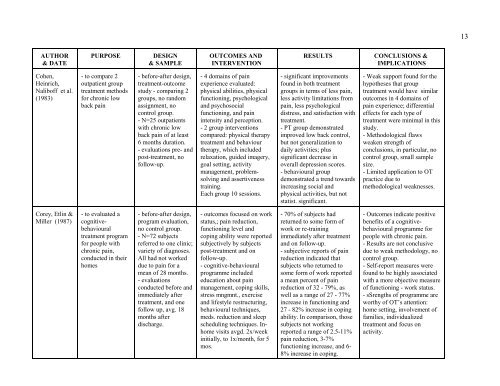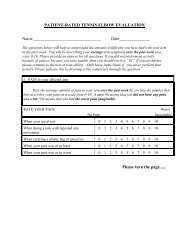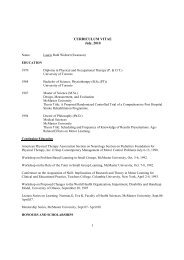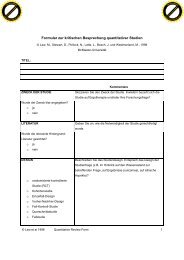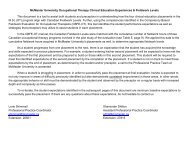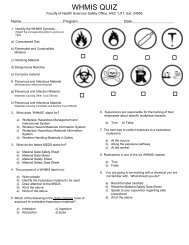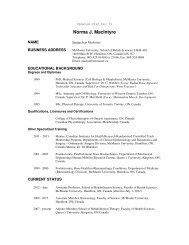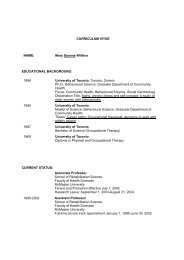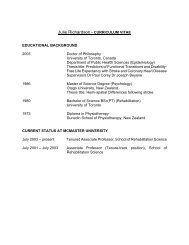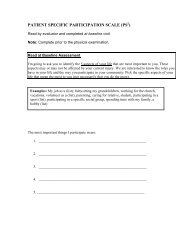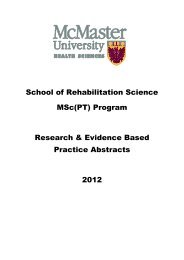The effectiveness of cognitive-behavioural interventions with people ...
The effectiveness of cognitive-behavioural interventions with people ...
The effectiveness of cognitive-behavioural interventions with people ...
You also want an ePaper? Increase the reach of your titles
YUMPU automatically turns print PDFs into web optimized ePapers that Google loves.
13AUTHOR& DATEPURPOSEDESIGN& SAMPLEOUTCOMES ANDINTERVENTIONRESULTSCONCLUSIONS &IMPLICATIONSCohen,Heinrich,Nalib<strong>of</strong>f et al.(1983)- to compare 2outpatient grouptreatment methodsfor chronic lowback pain- before-after design,treatment-outcomestudy - comparing 2groups, no randomassignment, nocontrol group.- N=25 outpatients<strong>with</strong> chronic lowback pain <strong>of</strong> at least6 months duration.- evaluations pre- andpost-treatment, n<strong>of</strong>ollow-up.- 4 domains <strong>of</strong> painexperience evaluated:physical abilities, physicalfunctioning, psychologicaland psychosocialfunctioning, and painintensity and perception.- 2 group <strong>interventions</strong>compared: physical therapytreatment and behaviourtherapy, which includedrelaxation, guided imagery,goal setting, activitymanagement, problemsolvingand assertivenesstraining.Each group 10 sessions.- significant improvementsfound in both treatmentgroups in terms <strong>of</strong> less pain,less activity limitations frompain, less psychologicaldistress, and satisfaction <strong>with</strong>treatment.- PT group demonstratedimproved low back control,but not generalization todaily activities; plussignificant decrease inoverall depression scores.- <strong>behavioural</strong> groupdemonstrated a trend towardsincreasing social andphysical activities, but notstatist. significant.- Weak support found for thehypotheses that grouptreatment would have similaroutcomes in 4 domains <strong>of</strong>pain experience; differentialeffects for each type <strong>of</strong>treatment were minimal in thisstudy.- Methodological flawsweaken strength <strong>of</strong>conclusions, in particular, nocontrol group, small samplesize.- Limited application to OTpractice due tomethodological weaknesses.Corey, Etlin &Miller (1987)- to evaluated a<strong>cognitive</strong><strong>behavioural</strong>treatment programfor <strong>people</strong> <strong>with</strong>chronic pain,conducted in theirhomes- before-after design,program evaluation,no control group.- N=72 subjectsreferred to one clinic;variety <strong>of</strong> diagnoses.All had not workeddue to pain for amean <strong>of</strong> 28 months.- evaluationsconducted before andimmediately aftertreatment, and onefollow up, avg. 18months afterdischarge.- outcomes focused on workstatus,; pain reduction,functioning level andcoping ability were reportedsubjectively by subjectspost-treatment and onfollow-up.- <strong>cognitive</strong>-<strong>behavioural</strong>programme includededucation about painmanagement, coping skills,stress mngmnt., exerciseand lifestyle restructuring,<strong>behavioural</strong> techniques,meds. reduction and sleepscheduling techniques. Inhomevisits avgd. 2x/weekinitially, to 1x/month, for 5mos.- 70% <strong>of</strong> subjects hadreturned to some form <strong>of</strong>work or re-trainingimmediately after treatmentand on follow-up.- subjective reports <strong>of</strong> painreduction indicated thatsubjects who returned tosome form <strong>of</strong> work reporteda mean percent <strong>of</strong> painreduction <strong>of</strong> 32 - 79%, aswell as a range <strong>of</strong> 27 - 77%increase in functioning and27 - 82% increase in copingability. In comparison, thosesubjects not workingreported a range <strong>of</strong> 2.5-11%pain reduction, 3-7%functioning increase, and 6-8% increase in coping.- Outcomes indicate positivebenefits <strong>of</strong> a <strong>cognitive</strong><strong>behavioural</strong>programme for<strong>people</strong> <strong>with</strong> chronic pain.- Results are not conclusivedue to weak methodology, nocontrol group.- Self-report measures werefound to be highly associated<strong>with</strong> a more objective measure<strong>of</strong> functioning - work status.- sSrengths <strong>of</strong> programme areworthy <strong>of</strong> OT’s attention:home setting, involvement <strong>of</strong>families, individualizedtreatment and focus onactivity.


